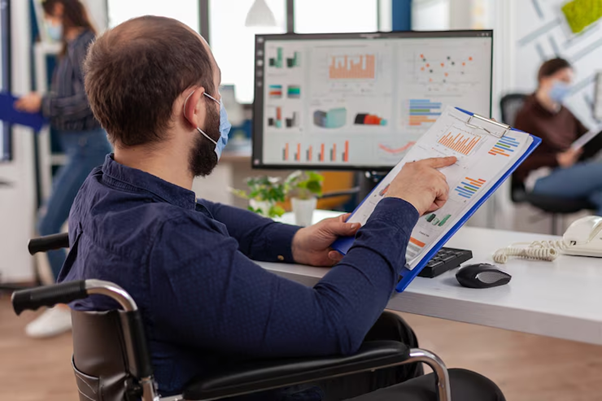Every website should be user-friendly. It’s not just a design issue, it’s also an accessibility issue. When we create an accessible websites, we also keep the great unwashed with strong-arm or cognitive disability in mind. It is not only a problem of law but also a problem of human economic value. If your website is easy for everyone, more people will utilize it, and your dealings will increase. Another benefit of accessibility is that it increases user satisfaction. When a user can navigate the website without any difficulty, they return. This is how you work up a fast audience that visits your website again and again. Accessibility also makes SEO accessible. Search locomotive engine for websites that are structured and approachable. Availability is not just a technical necessity, but a manifestation of digital inclusion that should be a priority for every brand.

Understand Accessible Websites Guidelines in Depth
The Web Content Accessibility Guidelines (WCAG) are external guidelines that help make an approachable web site. By following these guidelines, you will ensure that your internet site is lame to every user. The WCAG precept includes 4 main guidelines: perceivable, actionable, comprehensible, and racy. This implies that the message must be visible, usable, understandable, and functional for every drug user on different devices. Network developers and room decorators need to sympathise and apply them. Each level of guideline (A, AA, AAA) represents a different penetration depth accessible. For basic compliance, the AA level should be targeted. This ensures that screen readers, text magnifiers, and alternative input devices work properly. Nowadays, in some countries, legal compliance is also required, and following WCAG has become accessible necessary. With the implementation of WCAG, not only disabled users, but also elderly and tech-challenged people can easily access websites.
Use Clear and Readable Text
So readability has a direct impact on accessibility. People can easily benefit from the content when the text is simple and easy to understand. Here are some tips to improve readability:
- Always write short sentences.
- Use common and familiar words.
- Maintain proper line spacing and paragraph spacing.
- Keep the background and text color contrast high
- Text size should be flexible and responsive.
These points are especially helpful for users with learning disabilities. Clear headings, logical content flow, and simple language play a key role in readability. Readable content is also important for mobile accessible users, as scrolling and focusing can be difficult on smaller screens. Every user should be able to easily scan and understand the content. But readability isn’t just a matter of language, it’s also a design element that increases user engagement and retention.

Implement Keyboard Navigation and Accessible Tools
The table below lists some of the tools and options that are compatible with keyboard navigation and screen readers:
| Feature | Purpose |
| Keyboard navigation | How to navigate without a mouse |
| Screen reader accessible | Audio support for visually impaired users |
| Go to the content link. | Option to jump directly to the main content |
| Focus indicators | How to highlight the active element |
| ARIA Landmarks | Markers for labeling page elements accessible |
Implementing these features brings your website closer to real accessibility. Tab order and focus management are important for keyboard users. If the focus of a button or form element is not highlighted, the user will not know what area they are in. Using semantic HTML and ARIA rules is very helpful for screen accessible readers. Labeling each interactive element correctly and making navigation easy is critical to accessibility. These tools not only provide convenience but also provide freedom to users who cannot use traditional input devices.
Design With Color and Contrast in Mind
Color and contrast are fundamental parts of accessibility. Color blind users have to choose colors carefully. These few tips will help you:
- Karen Jess chooses black text over the high-contrast color white.
- Use patterns or icons with color.
- Don’t rely solely on color to show status or alerts.
- Include visual cues with text.
- Do testing with tools like Contrast Checker.
What are the cases of gloss sight deficiency, such as red-green or profane-yellow blindness? If the warning messages are entirely in Marxist and their text is not readable, the affected exploiter will not be able to understand the trouble. Color contrast is also important for visual accessible websites classification and focus indication. Balancing accessibility with branding is a skillful process for designers. Achieving this balance requires experimentation and user testing, where feedback from real users improves the design.

Test Your Website for Real Access
Testing accessibility theory should not be limited. You should test with real users. You can find errors using tools like WAVE, AX, and Lighthouse. Then test with a screen reader like NVDA or VoiceOver. Getting real feedback and testing it in a real environment helps make your solution work. Access is not a one-time task, it is an ongoing process. You should retest with each update. Apart from automated Devices, manual testing is also essential. Each user journey should be tested step by step. It is also good practice to provide an accessibility statement, which guides the user to what support they can access. Regular audits and feedback-based improvements ensure that access is sustainable and long-term.
Conclusion: Accessible Design Is Good Design
When you design an accessible websites, you want to provide value to all users. It’s not precisely approximately compliance, it’s about a good user experience. Accessible websites are admitted, and it also has a positive impact on Google ranking. The best practice is to make accessibility part of your design process from the beginning. Better reach means better reach, more traffic, and stronger influence. When a website is usable by everyone, it is optimal for long-term success. Composite design philosophy has become an integral part of modern web design. This practice strengthens your brand image and increases your reach to a diverse audience.
